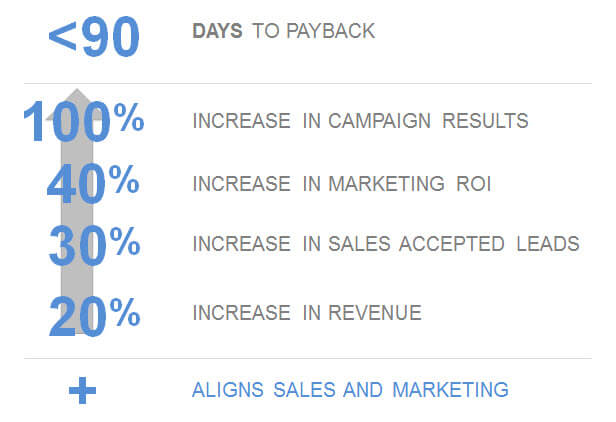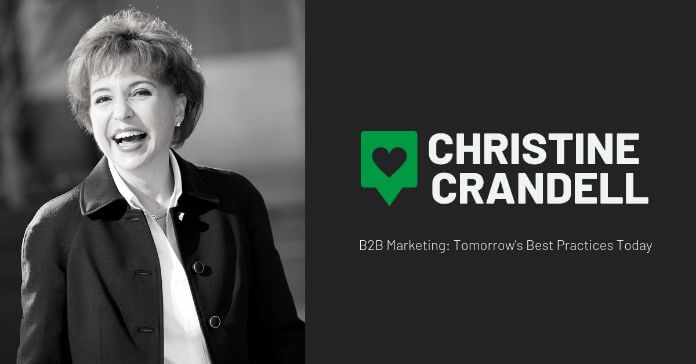In B2B Marketing: Tomorrow’s Best Practices Today, we feature expert interviews about the state of B2B Marketing and what the future holds. In this post, I interview Christine Crandell, Principal at New Business Strategies.
Tell us a bit about yourself?
I grew up in Europe and Turkey and am forever grateful for that experience. It taught me that despite different dress, religions and norms we all share the same hopes, dreams, and fears.
It also gave me a differentiation in my career as I understand different country business and social protocols and how to navigate them. Bridging cultures, as well as technical and business functions enabled me to work internationally my entire career.
Which countries have you worked in?
I’ve had some amazing experiences: working with French venture capitalists in Paris, presenting to Japanese investors in Tokyo, managing the sale of an international software company in Stockholm and helping open Oracle’s first office in Prague.
I have a MBA in International Finance with a minor in Information Technology (I’m a geek at heart) from Florida Atlantic University and a Doctorate in Business Administration from Golden Gate University.
Home, right now, is in the Santa Cruz Mountains and on a lake outside of Toronto, Canada, with my business partner husband and two very spoiled dogs. You can read more about my background on LinkedIn and on our website.
Tell us about your background in B2B marketing?
My first job out of college was with PriceWaterhouse as a management consultant. PwC found I had a knack for finding key and “hidden” patterns in large volumes of data.
This was long before ‘data-driven’ became a thing. I got started in B2B marketing when PwC tasked me to conduct research on the firm’s services/market needs. The results were instrumental in driving new revenue and market share. And I was hooked on marketing.
I joined SAP America when revenues were under $10million. There, I created the competitive analysis function, as well as the integrated demand generation and customer success models that were rolled out across the company. I also ran a development team in Waldorf that built the first global account management system on R/3 used by Sales for over seven years.
After SAP, we moved to Silicon Valley and I ran marketing for ASK Group, Oracle, Itron and served as CMO for IPLocks, Ariba, eGenera and Accept360. The rest is history.
How do you think about B2B Marketing?
I believe B2B Marketing is a three legged table: strategy, accountability, and customer alignment.
My approach is first and foremost rooted in the business strategy. Not BHAGs (“Big Hairy Audacious Goal”) or plans that get ‘created’ in a management offsite but from well-developed, researched and data-supported analyses of socioeconomic macro trends, customer patterns, competitive chessboards, and future paths based on scenario planning.
The result isn’t a big book but a focused ‘plan on a page’ that spells out time-bound and measurable objectives that absolutely have to happen to win. By focusing on new objectives – not status quo activities – I help my clients’ teams to ‘connect the dots’ between each person’s job, career aspirations and MBOs (“Management By Objectives”).
Something amazing happens: if everyone understands what needs to be achieved and what their role is in achieving that, then teams work better and deliver the results faster.
The third leg is having deep quantitative and qualitative knowledge of past, current and emerging target customer behaviors, expectations, and definitions of value. Our Sellers’ Compass® methodology grew out of my experiences as CMO of Ariba, eGenera, and client work.
Every touchpoint, marketing campaign, CTA, content, lead scoring is tied to journey map stages and continuously tested. Messaging, content strategy and sales enablement, is typically done in co-creation with customers. The results is higher ROI, faster agile cycles and what everyone cares about – demand that converts into revenue. Marketing Sherpa did a report on the ROI realized by one of our clients.
What are B2B marketers NOT doing well today?
Our clients are across technology, manufacturing and distribution sectors and the adage of ‘what is old is new’ continues to hold true. Over the past years, I’ve seen companies relax in defining their business strategy. Strategy is being treated much like marketing databases; they get relegated to the corner.
Why?
To do it right is hard and unsexy work that requires skills not often nurtured by leadership. Ironically, companies that are serious about strategy and market planning have substantially higher levels of success – revenue, reputation, innovation, loyalty, and profitability.
My advice to marketers is to get involved in strategic planning. By leading the planning process, marketers can ensure their company is market-led instead of sales or product-led. It also positions marketing to take on a broader, pivotal role in defining the future of the company. There are several methodologies that are time tested; we have used for two decades the Focus Framework.
Tell us a best-practice-of-tomorrow that B2B marketers should be doing today?
A best practice of tomorrow is to relook at how marketing is organized – skills, team structures and reporting relationships.
This time, take into account Artificial Intelligence. Look at what routine functions and processes AI can take over.
It won’t be entire roles but slices of job functions – vendors like people.ai – are a good example of what is capable.
Instead of organizing roles hierarchically, organize them into cross-functional teams around key customer segments.
Integrate has embraced this approach and is today a more agile and successful marketing organization.
Why should B2B marketers perform customer journey mapping?
Most companies do one of two things: Map the journey(s) they’d like their customers to take or map the journeys based on their Martech data. Unfortunately, both approaches deliver significantly less demand than they should.
The first is wishful thinking.
Buyers decide their own journey path and will not follow paths that vendors craft. Marketing campaigns, content, etc. tied to these types of journeys will repeatedly miss the mark.
The second is willful blindness.
Any Martech system, even if augmented with intent data, can only spot a lead when the buyer is halfway to purchase. These systems cannot capture what buyers did early on with other vendors or influencers.
The most effective customer journey mapping is developed qualitatively and outside-in. By capturing who they talk to, when, why, what content they seek, and where regardless of source or channel, brands can build journeys that are pretty comprehensive, detailed and contextual.
The objections I frequently hear to this approach are: It takes too long, customers/prospects won’t participate, Sales has this information, and they just need to know the three things to do differently that’ll impact conversion. Our response is “30 days, yes they will, no they don’t, and seriously?” We have the data to back up that up.
By developing outside-in journey maps the benefits are multi-fold. The ROI our clients have seen repeatedly from outside-in journey mapping is:

I talk about this further in a Forbes article and also stress that journey maps are not throw away one-time exercises.
What’s wrong with today’s B2B sales funnel?
The sales funnel model is relevant as a framework for measuring and reporting line-of-sight conversion metrics.
But that is not how they are used. Companies use them to define the sales process, what qualifiers determine which leads ‘move’ to the next stage, etc.. Sales funnels unconsciously reinforce the mindset that the vendor is in control of the sales process.
The second issue is that marketing and sales funnels should not be separated, they are part of one framework. Separating them unconsciously reinforces that the two teams should be managed differently and that leads are the handoff point; something we would all disagree with.
How do we fix the sales funnel?
To fix this, use the journey(s) to define the funnel model. What I’ve found is that the end of each journey stage is marked by a clearly defined internal decision that often vendors don’t know about.
But if you know what behavior to look for, you’ll spot the decision points – I call them tollgates. Fix the funnel by using the journey to define the stages and improve the accuracy of the funnel reporting.
Second, many companies use their funnel as a cookbook – this is who does what, when. The funnel is not a replacement for aligned sales methodologies and continuous coaching.
A number of Martech vendors streamline the building and monitoring of funnel models based on engagement analytics. Couple this with target sector/role journey maps and the funnel concept becomes a strategic framework for monitoring and managing buyer touchpoints, enablement and accurate pipeline forecasting.
How will B2B marketing be different in 2020?
There is trend that has been underway that will become more prevalent in 2020 – the blending of sales and marketing into one organization. Companies realize the tension between sales and marketing is untenable and the Chief Revenue Officer role hasn’t solved it.
This shift is taking a page out of the B2C world where Marketing own revenue and strategy.
I also see the Martech stack continuing to shrink coupled with a renewed investment in data and process integrity. A good portion of marketing’s issues are rooted in bad data and hygiene habits.
The last trend is increasingly sophisticated personalized campaigns. We now have the technology for true one-to-one B2B campaigns that mirror journeys and can be tuned to buyer roles and individual behaviors. That is exciting and will be a game changer.
If a CMO can only get one thing right in B2B marketing, what is it and why?
There is a clear realization that the marketing dialog in board meetings has been counterproductive when Directors and CEOs don’t understand marketing and CMOs/VPs don’t understand Board responsibilities.
Marketers have a tremendous opportunity to proactively help Board of Directors understand marketing and what the right questions are they should be asking.
Boards are focused on governance and struggle to connect the dots between CMO’s detailed metrics, which is essentially Greek to them, and whether the company on the right path to meet the investors and market expectations.
Marketers need to step in the shoes of Board members and then change their presentations to help Boards connect those dots.
Note: Download our Social Insights Report, “How Do CMO’s Engage on Social Media?”
Read more interviews
Listening to customers, the human element in Marketing and more with: Todd Wilms.
Influencer marketing, chatbots and more with: Neal Schaffer.
Content marketing, removing marketing automation and more with: Joe Pulizzi.


0 Comments on "B2B Marketing Q&A: Christine Crandell on the Sales Funnel, Customer Journey Mapping and More"